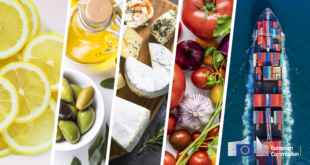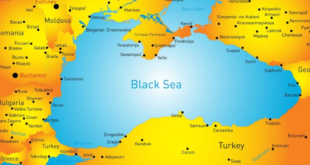By Berrak Birgili,

The Qur’an al-Kahf Surah 32-34. The verses describe the agro-forestry system and it is defined as a form of production that brings high income for years.
Surah: 32-” Give them the example of these two men, who We granted two vineyards to one of them, surrounded them with date palms, and placed a cultivated field between them. 33-Both of these gardens gave the expected product, and did not show any decrease in their yields. We had a stream flowing through each of them. 34- Thus, the owner of this garden was harvesting abundantly (…)
The system described in the verse is an agro-forestry production system. Because the combination of tree and product is described in the field. Agroforestry is the only agricultural production system proposed against climate change in the Kyoto Protocol. It is a traditional production system and is accepted as a department in various universities around the world. In Turkey, it was accepted as a Department of Horticulture, Faculty of Agriculture, by TUBITAK in 2014.
A “homegarden” type agroforestry system described in the verses, with dates in the outer ring, vine inside, and crops in the innermost part. “Homegarden” systems , which have been determined as an application type in the agroforestry literature list, have an important potential in carbon storage due to the high biomass they contain . “Homegardens” are also an important source of minerals and nutrients. In addition, homagardens provide food security with high product diversity for regions with dry periods such as Africa. These systems ensure an even distribution of food throughout the year . Traditional “homegardans” have been found to be ecologically sustainable . The biggest benefit is that it ensures the continuity of soil fertility, soil structure and nutrient cycle . The system creates a balance depending on biodiversity (Nair, 1993).
According to what is described in the Qur’an, these layers consisting of three different sizes of plants (date, vine, wheat) and the plant residues spilled from the layers and the humus formed by the deposits of birds and other animals form the above-ground C accumulation. C connected by roots constitutes C accumulated underground (Nair and Kumar, 2011). Conversion of accumulated C to organic matter:
1. To improve to structure of the soil and its sustainability.
2. Water holding capacity
3. Protect against deterioration and erosion
4. Continuity of soil moisture
5. Ensuring the continuity of microorganisms and mycorrhizae, which means soil vitality
6. Nutrient availability and availability
7. pH balance
8. High and continuous productivity ensures quality and continuous product supply.
The debris of these plants, planted close to each other, can feed the soil without the need for fertilizer, since the plant density is high. Again, because the plant density is very close and because of the shading, it is difficult to shelter weeds. The stream flowing through the middle of the two gardens provides continuous irrigation of these two close systems, which directly affects the yield.

The success of biological systems depends on biodiversity and soil strength. Homagardens give high and stable yields for hundreds of years. It is known that this system, which consists of 3 kinds of plants, continues for centuries. This shows us that the agro-ecological balance and biodiversity have increased in this long period. Maybe the system, which was established only as dates, vines and wheat at first, became birds, worms, reptiles, rodents over time. Useful grass has been a home to ant varieties.
The mentioned system takes place in the tropical region where homagardens are found. In other words, the farmer mentioned in the verse is located in countries located between 10 degrees north and 20 degrees south of the equator line, which is a tropical climate zone. (Bolivia, Brazil, Venezuela, Sudan, Chad, Nigeria, Mauritania, Colombia)( Anonymous, 2022). In the Homegarden system, the plant design in the field is ordered from the tallest to the one that grows on the ground, with the logic of the plants shading each other. That is, in the shadow of the date, there is a vine, and in the shadow of the vine, there is a crop. This is a precaution against the intense heat of summer in the tropics. In addition, the frequency of the plants protects the soil moisture and prevents the air humidity from falling. There are three important varieties of date, grape and wheat, which are important for human food. When dates, grapes and wheat are examined in terms of food values, it shows that the date has a high protein, mineral structure, has the capacity to be fed as a long-term food alone, the energy of the grape and the starch of the wheat together with the amino acids show that the system is valuable enough to provide high income. The Qur’an speaks of a stable and high financial gain that lasts for many years. The owner of the gardens, while meeting the food needs of his house, gets rich by using the rest in trade. Especially the high value of building material, sugar food supplement, decoration material and timber supports this income. The fact that grapes are processed to respond to many different needs and that wheat is the main food item increases the income of this system.
The Quran is the reference book of millions of people around the world. In the world of 2022, where solutions for climate change are discussed, the verses in which the system is described exactly were found to be exciting. We have discussed agroforestry, which is a traditional agricultural technique in terms of general definition and which is already known to contain thousands of years of knowledge. We will try to examine other conditions that affect yield, sustainability and land management.
REFERENCES
- Anonymous 2022, https://iklimler.com/tropikal-iklim-hangi-ulkelerde-gorunur/
- Esed.M,1996, The Message of the Qur’an İşaret Publishes
- NAIR, PKR, 1993, Introduction to Agroforestry, KLUWER Academic Publishes, London
- NAIR P.K.R.,KUMAR M.B.,2011, Carbon Sequestration Potential of Agroforestry Ssystems, SpiringerLink
 THE GLOBAL WINDOW OF TURKISH FOOD AND AGRICULTURE The Global Window of Turkish Food and Agriculture Sector
THE GLOBAL WINDOW OF TURKISH FOOD AND AGRICULTURE The Global Window of Turkish Food and Agriculture Sector









